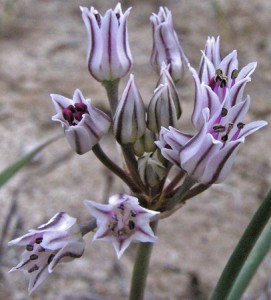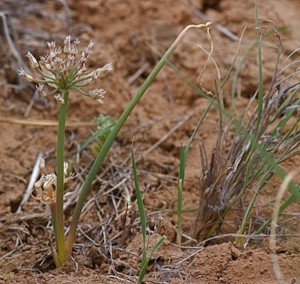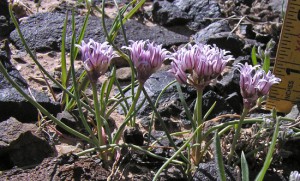Scientific name: Allium macropetalum
Common name: Desert onion, wild onion
Family: Amaryllidaceae (formerly classified as Liliaceae)
Article by Susan Bruneni

Allium macropetalum by Al Schneider. Semi-desert. Openings. Spring.
BLM lands south of Bloomfield, New Mexico, April 23, 2007. © Al Schneider
Allium macropetalum, the desert onion, is a species of wild onion native to the desert regions of the southwestern United States and northwestern Mexico. It grows on desert plains and hills in Sonora (Mexico),and the U.S. states of Arizona, Utah, Colorado, New Mexico, and Texas, at elevations up to 8,000 feet.
The name Allium is the Latin word for garlic, another member of the family which also includes shallots, leeks and chives. A number of Allium species are termed wild onions because they are native species and not part of a large number of cultivated varieties.
The desert onion thrives with full sun and medium well-drained soil. It can also be planted in cultivated beds for its showy spring flowers, as long as growing conditions are the same as the native conditions where it thrives. The desert onion favors habitats drier and less wooded than other wild onions. In the spring the flowers may form a massive display because they spread underground and can cover a large area.

Allium macropetalum full growth habit (Photo by Janice Tucker at Leonora Curtin Wetland Preserve).
The desert onion produces attractive bell-shaped flowers, mostly light pink but with a distinct, dark pink or purple vertical stripe along the middle. Flowers are hermaphrodite (male and female parts). They have six petals and occur in clusters of 10-20 heads with narrow linear leaves. They bloom March through June, varying by latitude. Plants grow from 6 – 12 inches in height.
As with most members of the onion family, the desert onion is edible, raw or cooked (note: there are other plants similar in appearance that are not edible and may even be toxic). Native Americans would singe the bulb to reduce the strong flavor. They were also dried and stored for winter use.
Juice of the plant is used as a moth repellent. The whole plant will repel many insects and is said to deter moles. The onion has a long tradition of medicinal uses for a wide variety of conditions covering everything from teething babies to snakebite cures. Today the onion has achieved the notable title of “super-food” due to sulfur compounds in the plant.

Allium macropetalum by © Al Schneider.
Leonora Curtin referred to a similar variety to allium found in dry areas, in Healing Herbs of Northern New Mexico, Allium cernuum, found in less arid habitats and higher elevations than Allium macropetalum. She traces the various names for wild onions used by Spanish settlers back to quotes from Montezuma by Spanish chroniclers. The many species in the onion family continue to be praised for their curative powers. She includes remedies for reducing fevers and says “they may be eaten raw or cooked, especially with meat, and are considered quite palatable and nourishing if consumed in either way”.
References:
Southwest Colorado Wildflowers, Allium macropetalum, swcoloradowildflowers.com
USDA, NRCS. 2017. The PLANTS Database (http://plants.usda.gov, 26 October 2017). National Plant Data Team, Greensboro, NC 27401-4901 USA.
Lady Bird Johnson Wildflower Center at The University of Texas at Austin, wildflower.org
Plants for a Future, pfaf.org


